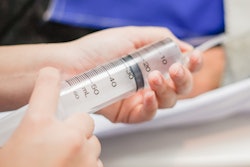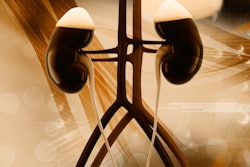
If given a choice between drinking oral CT contrast and missing a finding on an unenhanced imaging scan, patients prefer the contrast, according to results of a study published August 28 in the Journal of the American College of Radiology.
 Senior author Dr. Matthew Davenport.
Senior author Dr. Matthew Davenport.
The group, led by first author Dr. Sean Woolen and senior author Dr. Matthew Davenport, noted that oral contrast was necessary in the early days of CT scanner development to opacify and distend the bowel, making it easier to detect a number of different abnormalities. However, improvements in CT scanner technology have minimized artifacts from bowel motion and have improved visualization, arguably making oral contrast less important.
 First author Dr. Sean Woolen.
First author Dr. Sean Woolen.Recent research has also pointed to shortcomings of oral CT contrast, such as inadequate timing or poor patient compliance. What's more, drinking oral contrast can be uncomfortable for patients, the authors noted. These drawbacks have led some to argue that intravenous contrast is sufficient for most CT indications.
However, the authors listed a number of cases in which oral CT contrast could offer useful information. They therefore decided to perform a survey of patient preferences to measure the value of oral contrast from their perspective.
Woolen, Davenport, and colleagues surveyed adult patients who received oral contrast between August 2016 and March 2017 at two outpatient imaging centers. In all, 218 patients agreed to participate, and they were given surveys asking their opinion on the taste of oral contrast, as well as their experiences with the material and their aversion to risk. They were specifically asked what amount of risk -- on a scale of 0% to 10% -- they would be willing to take that their radiologist might miss a finding if they didn't have to drink contrast.
Participants were also asked: "Would you be willing to take a chance that your doctors might miss an important finding if you could avoid drinking the oral contrast?" Their responses to the question are shown in the table below.
| Patient responses to whether they would skip oral CT contrast | |
| Patient response | Percent |
| No, I would take no risk of missing an important finding | 89% |
| Yes, I would always avoid oral contrast regardless of risk | 2% |
| Possibly, depending on the level of risk | 9% |
In further analysis of the data, the researchers found that if oral contrast material improved the sensitivity of outpatient abdominopelvic CT by at least one percentage point, 97% of outpatients would prefer to use it.
The authors interpreted the results as indicating that oral CT contrast continues to have value, despite the efforts of some radiology practices to discontinue routine use of it.
"Given the value patients place on oral contrast material, efforts on the part of the imaging community to minimize its discomfort while maintaining its advantages are likely to be worthwhile and relevant," they concluded.




















